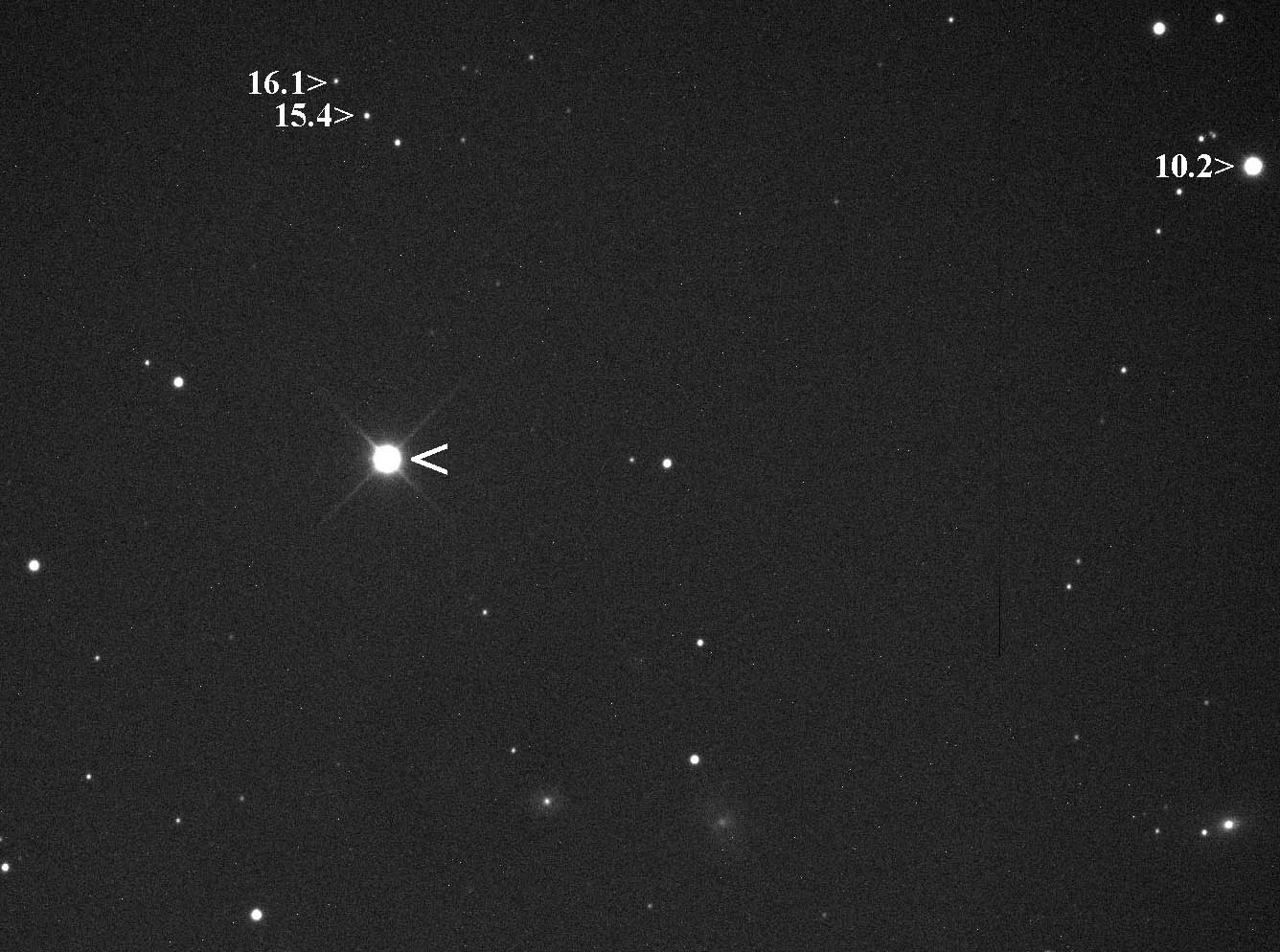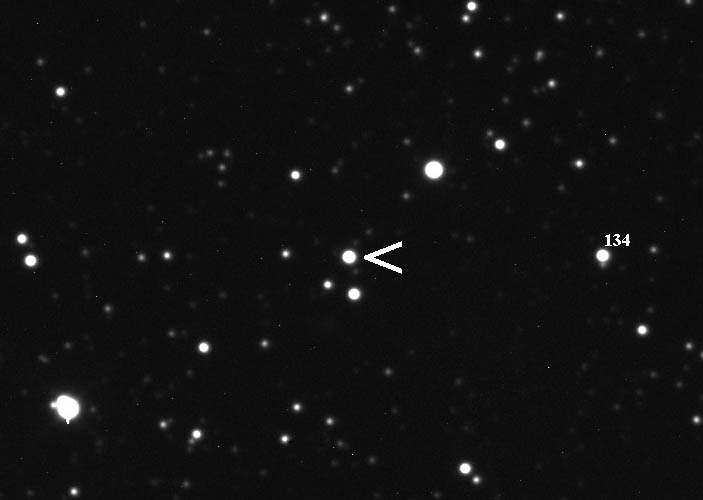|
V476 Cygni
V476 Cygni or Nova Cygni 1920 was a nova which occurred in the constellation Cygnus in 1920. It was discovered by William Frederick Denning, an English amateur astronomer, at 09:30 GMT on 20 August 1920, at which time it had a magnitude of 3.7. It reached a peak brightness of magnitude 1.7 on 23 August 1920. Its quiescent brightness is magnitude 17.09. V476 Cygni's light curve is quite unusual, showing a rapid decline from maximum brightness, followed by a slow nearly linear fading. It is classified as a very fast nova, with a very long tail. The light curve shows a "dust dip", a fast decline to a local brightness minimum, then a small increase in brightness, and finally a long, slow decline. This dust dip is believed to coincide with the formation of dust in the material ejected from the nova as it moves away from the star and cools. All novae consist of a close binary star pair, with a white dwarf star and a "donor" star orbiting each other. The stars are so clos ... [...More Info...] [...Related Items...] OR: [Wikipedia] [Google] [Baidu] |
White Dwarf
A white dwarf is a Compact star, stellar core remnant composed mostly of electron-degenerate matter. A white dwarf is very density, dense: in an Earth sized volume, it packs a mass that is comparable to the Sun. No nuclear fusion takes place in a white dwarf; what light it radiates is from its residual heat. The nearest known white dwarf is Sirius B, at 8.6 light years, the smaller component of the Sirius binary star. There are currently thought to be eight white dwarfs among the hundred star systems nearest the Sun. The unusual faintness of white dwarfs was first recognized in 1910. The name ''white dwarf'' was coined by Willem Jacob Luyten in 1922. White dwarfs are thought to be the final stellar evolution, evolutionary state of stars whose mass is not high enough to become a neutron star or black hole. This includes over 97% of the stars in the Milky Way. After the hydrogen-stellar nucleosynthesis, fusing period of a main sequence, main-sequence star of Stellar mass, lo ... [...More Info...] [...Related Items...] OR: [Wikipedia] [Google] [Baidu] |
1920 In Science
The year 1920 in science and technology involved some significant events, listed below. Astronomy and space science * January 13 – ''The New York Times'' ridicules rocket scientist Robert H. Goddard, stating that spaceflight is impossible. In 1969, with Apollo 11 on its way to the Moon, the newspaper will publicly retract this position. * December 13 – The red giant star Betelgeuse is the first to have its diameter determined by an optical astronomical interferometer, the Michelson stellar interferometer on Mount Wilson Observatory's reflector telescope. Biology * Andrew Douglass proposes dendrochronology dating. * Approximate date – The HIV pandemic almost certainly originates in Léopoldville, modern-day Kinshasa, the capital of the Belgian Congo. Chemistry * July 15 – F. W. Aston shows that the molar mass of chlorine (35.45) is a weighted average of the almost integral masses for the two isotopes 35Cl and 37Cl. History of science and technology * September 10 – ... [...More Info...] [...Related Items...] OR: [Wikipedia] [Google] [Baidu] |
Novae
A nova ( novae or novas) is a transient astronomical event that causes the sudden appearance of a bright, apparently "new" star (hence the name "nova", Latin for "new") that slowly fades over weeks or months. All observed novae involve white dwarfs in close binary systems, but causes of the dramatic appearance of a nova vary, depending on the circumstances of the two progenitor stars. The main sub-classes of novae are classical novae, recurrent novae (RNe), and dwarf novae. They are all considered to be cataclysmic variable stars. Classical nova eruptions are the most common type. This type is usually created in a close binary star system consisting of a white dwarf and either a main sequence, subgiant, or red giant star. If the orbital period of the system is a few days or less, the white dwarf is close enough to its companion star to draw accreted matter onto its surface, creating a dense but shallow atmosphere. This atmosphere, mostly consisting of hydrogen, is heated by ... [...More Info...] [...Related Items...] OR: [Wikipedia] [Google] [Baidu] |
Nordic Optical Telescope
The Nordic Optical Telescope (NOT) is an astronomical telescope located at Roque de los Muchachos Observatory, La Palma in the Canary Islands. The telescope saw first light in 1988, and was officially inaugurated during September 1989. Regular observing started in 1990. It is funded by Denmark, Sweden, Norway, Finland, and (since 1997) Iceland. Access is provided directly to astronomers of the funding countries, and of all nationalities through international time allocation committees. The main mirror has a diameter of . The optical forming was done at the optical laboratory at the Tuorla Observatory, on mirror blanks made of Zerodur at Schott Glaswerke in Mainz, Germany. While the NOT was designed as a passive telescope, with the mirror sufficiently thick to keep its shape even without an active feedback loop, its mirror was designed to be suspended on a pneumatic support system. The designers had planned that this and the flexibility of the mirror would allow for the impleme ... [...More Info...] [...Related Items...] OR: [Wikipedia] [Google] [Baidu] |
William Herschel Telescope
The William Herschel Telescope (WHT) is a optical and near-infrared reflecting telescope located at the Roque de los Muchachos Observatory on the island of La Palma in the Canary Islands, Spain. The telescope, which is named after William Herschel, the discoverer of the planet Uranus, is part of the Isaac Newton Group of Telescopes. It is funded by research councils from the United Kingdom, the Netherlands and Spain. At the time of construction in 1987, the WHT was the third largest single optical telescope in the world.The BTA-6 (6.0 m) and Hale Telescope (5.1 m) were both larger; the Multiple Mirror Telescope also had a larger collecting area but did not have a single primary mirror It is currently the second largest in Europe,The neighbouring Gran Telescopio Canarias (10.4 m) overtook the WHT in 2009 to become the largest in Europe and was the last telescope constructed by Grubb Parsons in their 150-year history. The WHT is equipped with a wide range of i ... [...More Info...] [...Related Items...] OR: [Wikipedia] [Google] [Baidu] |
Hubble Space Telescope
The Hubble Space Telescope (HST or Hubble) is a space telescope that was launched into low Earth orbit in 1990 and remains in operation. It was not the Orbiting Solar Observatory, first space telescope, but it is one of the largest and most versatile, renowned as a vital research tool and as a public relations boon for astronomy. The Hubble Space Telescope is named after astronomer Edwin Hubble and is one of NASA's Great Observatories program, Great Observatories. The Space Telescope Science Institute (STScI) selects Hubble's targets and processes the resulting data, while the Goddard Space Flight Center (GSFC) controls the spacecraft. Hubble features a mirror, and its five main instruments observe in the ultraviolet, visible spectrum, visible, and near-infrared regions of the electromagnetic spectrum. Hubble's orbit outside the distortion of atmosphere of Earth, Earth's atmosphere allows it to capture extremely high-resolution images with substantially lower background lig ... [...More Info...] [...Related Items...] OR: [Wikipedia] [Google] [Baidu] |
Nova Remnant
A nova remnant is made up of the material either left behind by a sudden explosive fusion eruption by classical novae, or from multiple ejections by recurrent novae. Over their short lifetimes, nova shells show expansion velocities of around 1000 km/s, whose faint nebulosities are usually illuminated by their progenitor stars via light echos as observed with the spherical shell of Nova Persei 1901 or the energies remaining in the expanding bubbles like T Pyxidis. Form Most novae require a close binary system, with a white dwarf and a main sequence, sub-giant, or red giant star, or the merging of two red dwarfs, so probably all nova remnants must be associated with binaries. This theoretically means these nebula shapes might be affected by their central progenitor stars and the amount of matter ejected by novae. The shapes of these nova nebulae are of much interest to modern astrophysicists. Nova remnants when compared to supernova remnants or planetary nebulae generate much ... [...More Info...] [...Related Items...] OR: [Wikipedia] [Google] [Baidu] |
Emission Nebula
An emission nebula is a nebula formed of ionized gases that emit light of various wavelengths. The most common source of ionization is high-energy ultraviolet photons emitted from a nearby hot star. Among the several different types of emission nebulae are H II regions, in which star formation is taking place and young, massive stars are the source of the ionizing photons; and planetary nebulae, in which a dying star has thrown off its outer layers, with the exposed hot core then ionizing them.Nebulae< ... [...More Info...] [...Related Items...] OR: [Wikipedia] [Google] [Baidu] |
Dwarf Nova
A dwarf nova (pl. wiktionary:nova, novae), or U Geminorum variable, is one of several types of cataclysmic variable star, consisting of a close binary star system in which one of the components is a white dwarf that accretion disk, accretes matter from its companion. Dwarf novae are dimmer and repeat more often than "classical" novae. Overview The first one to be observed was U Geminorum in 1855; however, the mechanism was not known until 1974, when Brian Warner (astronomer), Brian Warner showed that the nova is due to the increase of the luminosity of the accretion disk. They are similar to classical novae in that the white dwarf is involved in periodic outbursts, but the mechanisms are different. nova, Classical novae result from the fusion and detonation of accreted hydrogen on the primary's surface. Current theory suggests that dwarf novae result from instability in the accretion disk, when gas in the disk reaches a critical temperature that causes a change in viscosity, result ... [...More Info...] [...Related Items...] OR: [Wikipedia] [Google] [Baidu] |
Solar Mass
The solar mass () is a frequently used unit of mass in astronomy, equal to approximately . It is approximately equal to the mass of the Sun. It is often used to indicate the masses of other stars, as well as stellar clusters, nebulae, galaxies and black holes. More precisely, the mass of the Sun is The solar mass is about times the mass of Earth (), or times the mass of Jupiter (). History of measurement The value of the gravitational constant was first derived from measurements that were made by Henry Cavendish in 1798 with a torsion balance. The value he obtained differs by only 1% from the modern value, but was not as precise. The diurnal parallax of the Sun was accurately measured during the transits of Venus in 1761 and 1769, yielding a value of (9 arcseconds, compared to the present value of ). From the value of the diurnal parallax, one can determine the distance to the Sun from the geometry of Earth. The first known estimate of the solar mass was by ... [...More Info...] [...Related Items...] OR: [Wikipedia] [Google] [Baidu] |
Light Curve
In astronomy, a light curve is a graph (discrete mathematics), graph of the Radiance, light intensity of a celestial object or region as a function of time, typically with the magnitude (astronomy), magnitude of light received on the ''y''-axis and with time on the ''x''-axis. The light is usually in a particular frequency interval or frequency band, band. Light curves can be periodic, as in the case of eclipsing binary, eclipsing binaries, Cepheid variables, other periodic variables, and Methods of detecting extrasolar planets#Transit photometry, transiting extrasolar planets; or aperiodic, like the light curve of a nova, cataclysmic variable star, supernova, gravitational microlensing, microlensing event, or binary as observed during occultation events. The study of a light curve and other observations can yield considerable information about the physical process that produces such a light curve, or constrain the physical theories about it. Variable stars Graphs of the ap ... [...More Info...] [...Related Items...] OR: [Wikipedia] [Google] [Baidu] |





